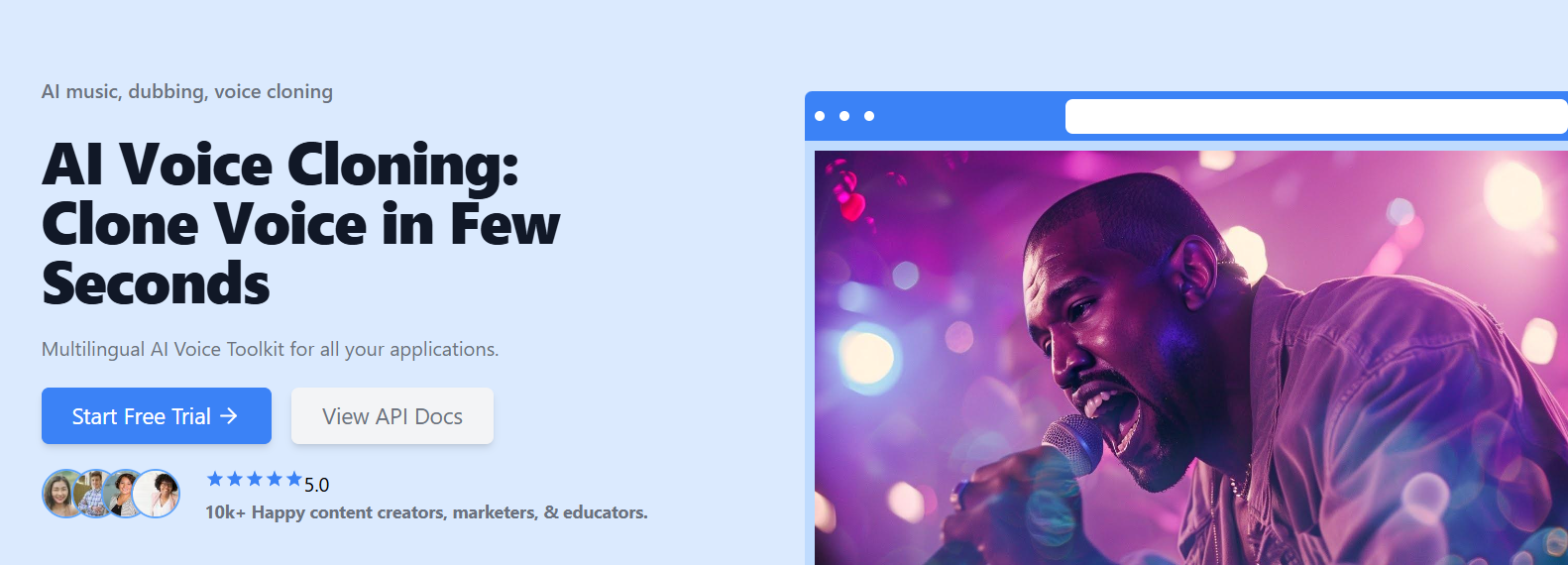Best Voice Cloning AI: 30-Second Phrase to Get AI to Copy Your Voice Perfectly
Written on . Posted in AI.
AI technology has grown rapidly in the last few years, digitizing many industries. Voice cloning technology, a branch of AI, uses an AI voice generator to clone your voice and generate speech that sounds just like the original voice.
This innovative technology is gaining attention across various industries, from entertainment to customer service. It is especially useful for creators, influencers, or anyone who uses their voice extensively for work or communication.
But what exactly is voice cloning, and why is it important? This detailed guide will help you understand the significance of voice cloning, how it works, and how to create the perfect 30-second phrase for the most accurate voice replication.
Want to get started right away? Check out ModelsLab’s voice cloning capabilities.
What is Voice Cloning?
Voice cloning uses AI to create voice clones, which are synthetic replicas of a human voice. By analyzing and reproducing the sound patterns of a specific voice, this technology can generate a cloned voice that is nearly similar to the original.
Unlike simple voice recording, voice cloning creates a dynamic, digital voice capable of saying anything in the tone and style of the sampled voice. This technology uses advanced AI and machine learning algorithms.
Voice cloning technology has rapidly advanced, resulting in more accurate and lifelike voice replicas. It’s important to distinguish voice cloning from other voice technologies such as text-to-speech (TTS) or speech-to-text (STT). While TTS converts text into synthetic speech, voice cloning focuses on mimicking the unique qualities of an individual’s voice.
How Does Voice Cloning Work?
Voice cloning involves a series of steps that collectively replicate a person’s voice. Here’s how it typically works:
Firstly, a significant amount of voice data from the targeted individual are gathered. These recordings, amounting to several hours, capture the full spectrum of speech patterns and nuances.
Next, the collected audio undergoes analysis. This process breaks the recordings into phonemes, the fundamental units of speech sounds, while also scrutinizing aspects such as pitch, tone, and tempo.
Following this, distinct characteristics of the voice are extracted. These include elements like accent, intonation, and rhythm, which contribute to the voice’s unique identity.
The AI model is then trained using these extracted features. Usually implemented as a neural network, the model learns to replicate the specific nuances and traits of the targeted voice.
Once trained, the AI model can synthesize new speech in the cloned voice. This synthesized speech undergoes fine-tuning to ensure it maintains naturalness and faithfully mirrors the original voice’s subtleties.
Ensuring good recording conditions and using high-quality equipment are important steps in creating a high-quality voice clone.
Finally, the AI generates the cloned voice output. This output is capable of delivering any scripted content while preserving the authentic style and tone of the original voice.
Why You Need an AI Assistant That Sounds Just Like You
AI assistants with voice cloning technology are transforming entertainment and customer service. In entertainment, they automate video voiceovers and interactive storytelling using AI voices that mimic human speech.
In customer service, these AI systems provide round-the-clock support and handle routine queries efficiently with voice replication software. Some other uses include creating podcasts, and trailers and assisting banks with customer inquiries using AI voice mimicry.
By integrating AI assistants, organizations in both entertainment and customer service sectors can optimize operations, improve engagement through personalized interactions, and improve overall customer satisfaction levels.
The Single Most Effective 30-Second Phrase to Train AI and Replicate Your Voice
To achieve accurate AI voice cloning, selecting the best phrase for training is important. This short script serves as necessary voice training data, providing AI with a focused sample of your voice. The chosen phrase, or voice cloning script, should include common words and reflect natural speech patterns.
This approach ensures that AI voice training captures nuances like intonation and accent effectively, improving the originality of the voice clone.
Tips for Selecting the Right Phrase
Use Common Words: Select words commonly used in your daily conversations to reflect natural speech.
Speak Naturally: Choose a phrase that mirrors your typical speaking style and rhythm.
Keep It Steady: Maintain consistent tone and volume throughout the recording to provide a clear sample for AI training.
Step-by-Step Instructions to Record and Use Your 30-Second Phrase for Flawless Voice Duplication
Here's a detailed step-by-step guide on recording and using your 30-second phrase for flawless voice duplication:
Preparing for Recording
To prepare for recording, choose a quiet indoor space with minimal background noise. It’s important to use a high-quality microphone to ensure clear and accurate recording. These steps help in capturing original voice recordings suitable for various applications, including AI voice cloning.
Recording Your 30-Second Phrase
When recording your 30-second phrase, start by warming up to ensure smooth delivery. Position the microphone 6-12 inches away from your mouth and speak naturally and clearly. These steps help in capturing a clear and natural voice sample for effective use in AI voice cloning applications.
To ensure quality and clarity in your recording, carefully review it for any distortions or background noise. If necessary, re-record to achieve a clear and high-quality voice sample. This ensures optimal results when using the recording for AI voice cloning or other applications requiring pristine audio quality.
Uploading and Using Your Voice Sample
To begin, save your recording in WAV or MP3 format. Then, follow the specific instructions provided by your AI voice cloning platform to upload the file. Once uploaded, use ModelsLab's tools to generate new speech samples based on your recording.

Finally, compare these samples to your original voice and make any necessary adjustments to ensure an accurate match. These steps are necessary for achieving optimal results in AI voice cloning applications.
Real-Life Examples of Successful Voice Cloning with the 30-Second Phrase Technique
Voice cloning has many uses across different areas:
Entertainment
In movies, video games, and cartoons, voice cloning is widely used to create character voices. This technology helps studios make voiceovers that sound real and expressive, just like the characters they’re portraying, even if there aren’t actual voice actors present.
Personal Assistant
Voice cloning lets you personalize virtual assistants like Siri, Alexa, or Google Assistant by selecting a voice that you like. This makes your interactions with these assistants feel more personal and enjoyable.
Gaming
In games, voice cloning creates unique character voices that improve the gaming experience. It allows gamers to give personalities to game characters without needing multiple voice actors, saving time and costs.
IVR System
Voice cloning improves automated phone systems by making them sound more friendly and human-like. It helps businesses provide better customer service experiences over the phone.
Communication Devices
Voice cloning is incredibly beneficial for people who have difficulty speaking or have lost their voice due to illness. It allows them to use technology that speaks with their familiar voice, greatly improving their ability to communicate effectively and independently.
Customer Service
In customer service, voice cloning is important for making automated systems sound natural and interactive. This helps streamline interactions with customers, making the experience more personalized and similar to talking to a real person.
Podcasts and Audiobooks
Professional voice cloning is transforming the audiobook and podcast industries. It allows authors to narrate their books or produce podcasts without constant recording. This makes production faster and ensures a consistent narration style.
Educational
Voice cloning can create or recreate the voices of historical figures for educational and motivational videos, documentaries, or museum exhibits. This makes history come alive, providing a more immersive and engaging learning experience for people of all ages.
E-learning
Voice cloning makes e-learning more engaging by providing clear and consistent voiceovers for online courses. It helps educators create lessons that sound natural and can be easily understood by students worldwide.
YouTube Video
For YouTubers, voice cloning ensures videos have a consistent and professional narration style. It helps creators maintain a steady flow of content without constant re-recording.
Advertisement
Voice cloning lets advertisers create personalized audio ads quickly. They can tailor ads with specific details like names and locations, making them more appealing and relatable to listeners.
The Current Impact and Potential Future of Voice Cloning AI
As we explore AI voice cloning, it's important to understand its current impact and potential future in content creation.
The Evolving AI Voice Technologies
AI voice cloning technologies are advancing rapidly, with voice clone technology being a significant milestone. As algorithms become more sophisticated and training data improves, generative voice technology will become even more realistic and expressive. It’s not just about mimicking voices but improving their naturalness and functionality.
How AI Voice Cloning is Changing Content Creation
AI voice cloning is transforming content creation across various fields like advertising, entertainment, education, and accessibility. It allows creators to save time and money by generating natural-sounding AI voices quickly and efficiently. This technology frees up time for creative work and streamlines production processes.
Future Possibilities and Potential Applications
The future of voice AI is full of exciting opportunities. We can expect advancements that enable voice synthesis in multiple languages with higher accuracy. Applications may include virtual reality, gaming, and interactive storytelling, offering immersive experiences. Personalized AI companions with unique voices might also become more common, improving human-computer interactions.
Balancing Innovation with Ethical Responsibility
As AI voice cloning evolves, it's essential to balance innovation with ethical responsibility. While AI offers many benefits, it's important to address ethical concerns and ensure responsible use. Upholding ethical standards and preventing misuse should be a priority as this technology develops.
Start Voice Cloning Today with Modelslab
Voice cloning is an exciting technology that can create exact replicas of human voices, offering numerous benefits. It can personalize digital interactions and help preserve languages, but it also raises ethical concerns. The ability to mimic someone's voice so accurately can lead to misuse if not managed properly.
As voice cloning becomes more common, it's essential to develop strong ethical guidelines and legal rules to ensure its responsible use. These measures should focus on obtaining consent, maintaining authenticity, and ensuring transparency. Developers and users alike need to understand the ethical implications and commit to using voice cloning responsibly.

The future of voice cloning isn't just about technological progress. It's also about using this powerful tool wisely to improve communication and creativity. By balancing innovation with responsibility, we can unlock the full potential of voice cloning.
Ready to Transform Your Projects with Modelslab's Voice Cloning? Clone Your Voice in Seconds with Our Multilingual AI Voice Cloning Toolkit. Get Started Now!
